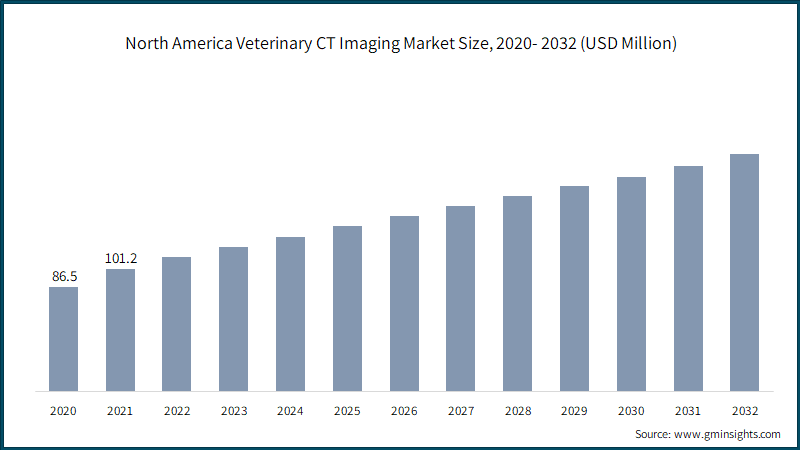Home > Animal Health & Nutrition > Veterinary Medical Devices > Veterinary CT Imaging Market
Veterinary CT Imaging Market Analysis
- Report ID: GMI5904
- Published Date: May 2023
- Report Format: PDF
Veterinary CT Imaging Market Analysis
Based on product, the veterinary CT imaging market is segmented as hardware, software, and consumables. The hardware segment further divided into stationary CT scanner, and portable CT scanner. In 2022, the hardware segment accounted for the majority of the I market owing to the high cost of instrument. There is a growing recognition of the value of CT imaging in veterinary medicine, leading to an increased adoption of CT scanners in veterinary practices. Veterinarians are realizing the benefits of CT imaging in diagnosing and treating various conditions, including orthopedic, neurological, and oncological disorders in animals. This increased progression for CT imaging drives the need for advanced hardware systems.
Based on portability, Stationary CT scanners segment is further sub-segmented as mid end CT scanner, high end CT scanner, and low-end CT scanner. The stationary CT scanner segment held the dominant market share of 77.9% in 2022. Stationary CT scanners incorporate advanced technologies, such as multi-detector arrays, which can capture images with higher spatial resolution and improved image quality. This helps in better visualization of small anatomical structures, subtle lesions, and soft tissue details, leading to more accurate diagnoses and treatment planning.

Based on animal type, the market is segmented as companion animals, livestock animals, and other animal types. The companion animals held a dominant market share of around 64.6% in 2022. The large share of this segment can be attributed to the increasing awareness of pet owners, advancements in veterinary medicine, the growing bond between humans and pets, increasing spending on animal’s health and the availability of specialized veterinary care.
Furthermore, the veterinary CT imaging market has witnessed significant technological advancements, making CT scanners more efficient, user-friendly, and accessible to veterinary practitioners. These advancements have led to improved image quality, faster scan times, and reduced radiation exposure, enhancing the overall experience for both pets and veterinarians.
Based on application, the veterinary CT imaging market is segmented as orthopedic & traumatology, dental, oncology, neurology, and other applications. The orthopedic & traumatology segment is expected to grow at a significant pace of 6.6% by 2032. Factors driving the growth of the orthopedic & traumatology segment are increased number of orthopedic injuries and increasing need for accurate and detailed imaging for diagnosing and treating orthopedic and traumatic injuries in animals.
CT imaging offers superior visualization of bone structures and soft tissues compared to traditional X-rays. It provides detailed 3D images, which are particularly valuable for assessing complex fractures, joint abnormalities, and soft tissue injuries. The ability of CT scanners to provide precise diagnostic information improves the accuracy of diagnoses in orthopedic and traumatology cases, leading to better treatment outcomes.
Based on end-user, the veterinary CT imaging market is segmented as veterinary hospitals & academic institutes, and veterinary clinics & diagnostic centers. The veterinary hospitals & academic institutes segment held a dominant market share in 2022 and is expected to grow at a significant pace by 2032.
Factors such as increasing demand for advanced diagnostic capabilities, growing awareness and acceptance of CT imaging, collaboration with specialists, teaching and research requirements, referral services for complex cases, enhanced patient care and outcomes, and technological advancements contribute to the adoption and utilization of CT scanners in veterinary hospitals and academic institutes.

North America veterinary CT imaging market is anticipated to grow at 5.7% by 2032. North America has a well-developed veterinary healthcare infrastructure with availability of numerous veterinary hospitals, specialty clinics, and academic institutes. These institutions have the resources and expertise to invest in advanced diagnostic equipment, including CT scanners. The presence of specialized veterinary professionals and advanced healthcare facilities drives the demand for veterinary CT imaging in the region.

